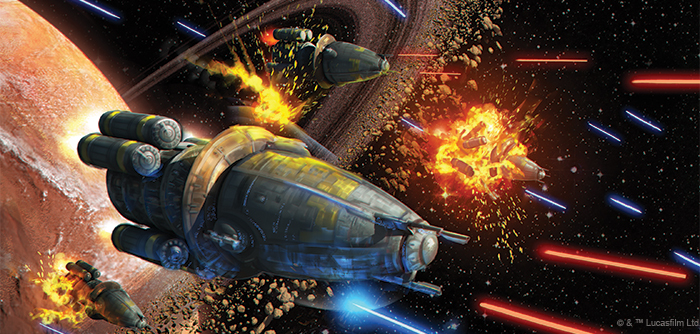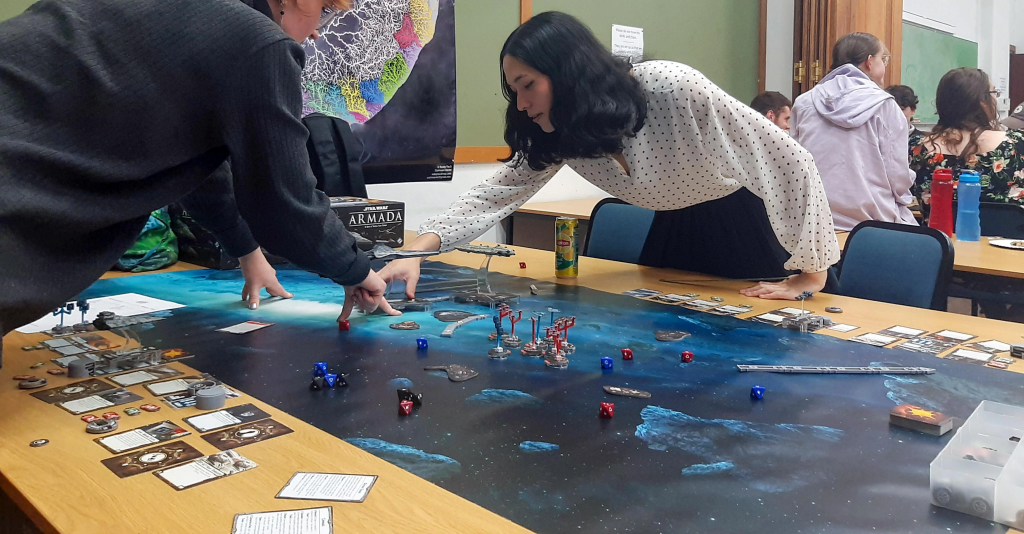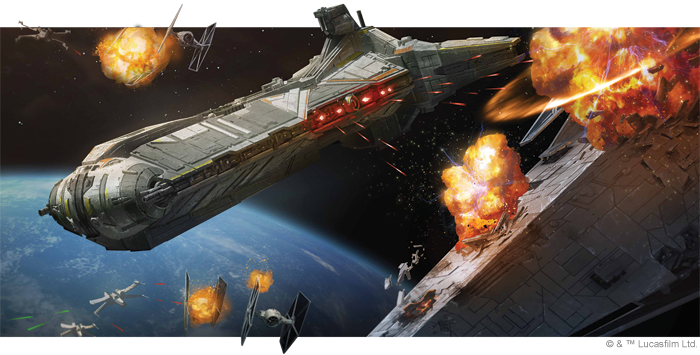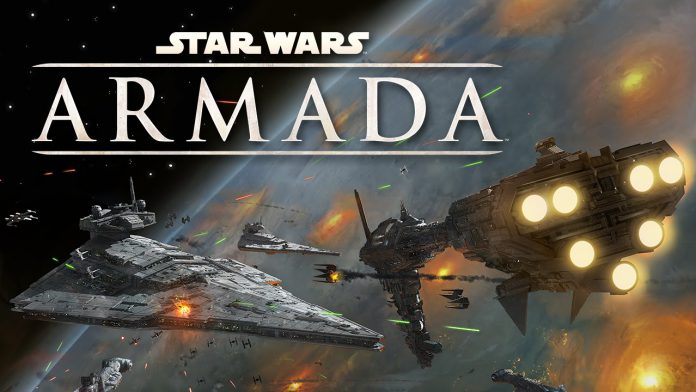Hi, I’m Summer and I’ve been entangled with Star Wars: Armada since 2016. In the intervening years, I’ve amassed a sizable ship collection, and dragged unsuspecting friends and partners into it. Today, I’m introducing you to the joys of plastic spaceships in the Star Wars universe.
The Basics – “You’ve taken your first step into a larger world.”
Star Wars: Armada (abbreviated as Armada among fans) is a tabletop wargame first produced by Fantasy Flight Games (FFG), and now Atomic Mass Games (AMG). Armada is a fleet wargame where players battle it out with capital ships and squadrons from the Star Wars universe. If you still have the heart of a child as I do, picture Armada as a game where you recreate the feel of being a fleet officer poring over a holographic table while a battle rages on in the background. It’s like that.
Besides that, Armada also has an agreeable entry barrier. The rules are available for free. The game is well-balanced in casual play, and raising a simple fleet up to the standard battle size won’t devour your wallet. The capital ships are pre-painted, which further reduces the entry barrier while giving you nice display models out-of-the-box. There’s also no need to procure or build scenery.

The Setup – “Acting out of emotion will not serve us here.”
Players bring fleets consisting of capital ships and squadrons to the table. Fleets are built from one of 4 factions: the Galactic Empire, Galactic Republic, Rebel Alliance and Separatist Alliance. A fleet’s size is determined by a point value system familiar to many wargamers, where each unit and upgrade incurs a cost against a point budget. Games are played on a surface measuring 3’ x 3’, 3’ x 6’, or larger. The standard format used in tournament play is 400 points per player, and is played on a 3’ x 6’ surface. A smaller format dubbed Task Force is played on a 3’ x 3’ surface and the larger Sector Fleet format (think Apocalypse for 40K) is played on a much larger area.
Victory conditions for each game are determined by objectives chosen prior to deployment. Objectives are a strategic pursuit that begins in fleet building, where each player picks three objectives that favour their fleet. Before deployment, the player who built their fleet with the fewest points chooses who has initiative (who activates first each turn). Since the first player to activate has an advantage in each round, the first player is forced to choose the objective for this game from the second player’s selection – all of which are unfavourable to them. So, the first player gets the bonus of acting first, but the game is played using the second player’s rules. This creates minigames in fleet construction. Do you refuse to spend some of your point budget in pursuit of initiative and the right to determine who acts first? This is called bidding. The objectives you choose are suited for your fleet, and different fleets favour different objectives. If you’re the first player, which of your opponent’s objectives do you pick, knowing they were tailored to ruin your day? Armada favours effective planning and adaptability. There are few advantages that are not balanced out by a drawback and the objective mechanic highlights that.
The fleet building and objective planning stages of the game capture the feel of mustering a fleet. Each hand-picked ship, squadron, commander, and upgrade contributes to a greater whole. However, the battlespace is inherently unpredictable and you cannot be certain who will have initiative unless you pay a hefty price to hold it.

The Gameplay – “Call up a Hammerhead corvette. I have an idea.”
Games of Armada are often won or lost in deployment. Capital ships must be placed to support squadrons, friendly ships and avoid obstacles. Don’t forget about the objective, either. Players alternate deployments (first player deploys first) at the edge of the play surface. Ships exit hyperspace and fighters launch from concealed positions. Players deploy their fleets with an eye toward victory: small ships form wolfpacks and large ships anchor the battle line. Squadrons dart near their motherships before a player inevitably drives a capital ship into their own squadrons, scattering them unfavourably. In Armada, your first adversary is your past self.
Combat takes up to 6 rounds, with 4 phases per round. First, players issue commands to their ships to determine priority tasks for a given round. Players may have to set commands multiple turns ahead of time, forcing them to anticipate the tempo of battle. This represents the sluggishness of larger ships versus the initiative and swiftness of smaller ships. In the second phase, ships activate and carry out their commands. First player activates first (see a pattern?) and the players alternate their activations. Ships shoot and move afterward – a deviation from the norm. This necessitates more planning, as players must anticipate their opponent’s movement to bring their most favourable weapons onto an enemy ship. Here, the big ships manoeuvre, command squadrons, attack and conduct vital repairs. After the capital ships activate, squadrons (at least, those who were not commanded by ships earlier) get their moment. They coordinate and bomb enemy ships, delay bombers, dogfight, and control objectives while capital ships burn around them. The last phase is bureaucracy – players reset spent upgrades and defences and prepare for the next round. Boring, but necessary.

Combat in Armada incorporates familiar and intuitive elements of wargaming with distinct twists. The fact that ships must shoot first and move afterward requires additional foresight. Weaponry sits on a familiar spectrum of damage and range, where long-range turbolasers are inconsistent, and close-range ordnance hits like a sledgehammer, but needs support to shine. And there are so many weapons! Joyous turbolasers, ion cannons and heavy ordnance specific to each ship and upgraded to each player’s taste. Capital ship fire and torpedoes lash into the void represented valiantly by candy-coloured dice. On the receiving end, the defender uses every defensive tool available to evade, redirect, brace for, and contain incoming damage. Sometimes, a return salvo is ordered. Shields fail under the intense pressure of capital-class weaponry and pinprick attacks from bomber pilots alike. Hull breach alarms blare. In the distance, a Star Destroyer breaks apart, shattered by a torpedo salvo.
The game ends after six rounds, at annihilation or surrender. Victory Points are calculated based on enemy units destroyed and objectives accomplished, and whoever has the most points is the winner. Do be sporting and offer a friendly handshake to the opposing admiral regardless of the battle’s outcome.
The Feel – “Your eyes can deceive you; don’t trust them.”
My enthusiasm for the narrative aspect of Armada stems from its excellent underlying design. Just like the other FFG properties (X-Wing, Star Wars: Legion), Armada is a game crafted with a passion for Star Wars and cohesive game design alike. Characters, ships and game mechanics act exactly as you would expect from the galaxy far, far away. Darth Vader in a fleet officer slot can choke out your other officers to encourage a ship’s gunners. When Obi-Wan commands a fleet, it plays steadily and defensively. Hondo Ohnaka plays for every team and feeds you an advantage, but also feeds your opponent a smaller advantage because he backstabbed you. When a capital ship suffers damage, its shields bear the damage first, represented clearly on a ship’s base by rotating indicators. Kyrsta Agate is an unrivalled leader for her large ship and is dead-set on flying it into danger. Re-create the scene in Episode III when a Venator-class star destroyer pulls up alongside Grievous’ Providence-class dreadnought and they wail on each other like the Age of Sail never went out of fashion.

Armada isn’t just a treat because the interaction of game mechanics and lore is consistent, but also because the game is generally well-balanced between factions. As is typical for FFG Star Wars properties, Armada is built on a bespoke ruleset with consistent core mechanics and a strong sense of internal balance. Numerous mechanics are counter-balanced so that the game never feels like it’s spiraling out of control. Players alternate their activations, which avoids the problem of the first player sweeping the table clean. Activating first is often advantageous, but is balanced by having to play the opponent’s objective. Dice control and mitigation are built into dozens of upgrades in lore-friendly ways, so probability seldom feels like the defining factor in a defeat. My casual games of Armada often end in a near-parity of Victory Points and surviving ships.
Armada also has a dedicated competitive setting consisting of store tournaments, a world championship and numerous online tournaments hosted on Tabletop Simulator and Vassal. Naturally, the balance changes when stakes are high and the meta-game of competitive Armada tends to favour a few dominant archetypes and their counters, with the occasional wildcard. Imperial players still wake up in a cold sweat hearing the name Rieekan echo in their minds. Demolisher remains a formidable ship after repeated nerfs and more recently, no player can enter a tournament without planning for (or just bringing) the dreaded Sloanager.
The Catch – “Not to worry, we are still flying half a ship.”
Every system has its drawbacks and issues and Armada isn’t exempt. Armada’s slow pace and strategic scope places it at odds with the ‘heroic’, big name character gameplay of mainstream wargaming. Fleet actions in Armada are abstract. There is a limit to how much personality you can ascribe to a card with Darth Vader’s face than your wonderfully converted Biker Ork Warboss. This niche status can also be a strength – much like its cousins Battlefleet Gothic and Dropfleet Commander, Armada has a highly dedicated fanbase who love spaceships and are eager to show you how Thermal Shields work.
At the time of writing, Armada has reached an unfortunate development trough. FFG’s license to produce Armada expired and all of its Star Wars properties (Armada, Legion, X-Wing) transferred over to AMG. AMG is a smaller company without the resources to manage such a diverse array of properties, especially during the pandemic years, and placed Armada’s development on hold for 2021 and 2022. The players are enduring a two-year content drought and we’ve only had some organised play support and print-and-play game content to tide us over. Yet, I remain hopeful for an eventual conclusion to the drought. Meanwhile, superbly passionate fans have continued to run tournaments, teach new players and run the game at our local clubs. We’re always looking for new players – ships don’t captain themselves, after all.

The Close – “Well, this ain’t a quick job! It’s a war!”
Star Wars: Armada is an excellently designed fleet wargame placed squarely in a beloved setting. If you have a love for capital ships and fleet combat in a slower-paced package, it’s one of the best-designed games of that type around. The players are a passionate lot and if you find one, you will be sucked into a discussion about the merits of plastic spaceships. In all likelihood, the person you’re talking to will also have a collection large enough to support multiple players (I certainly do). There is a content drought, but neither the gameplay nor we players are going anywhere and we will remain in command until formally relieved.
Have any questions or feedback? Want to see more content on Armada? Let us know by dropping a note in the comments below or emailing us at contact@goonhammer.com.


